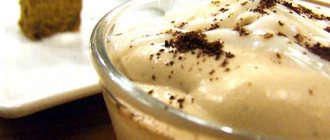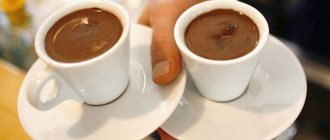The Russian language contains many words that are foreign in origin. The reason for this is that the objects they represent originally appeared in foreign-language societies and came to us with their own name. In our country they often continue to be called the same. However, the graphic form of borrowed words and their correct spelling can cause serious difficulties and discrepancies. For example, cappuccino. After all, many people love this drink for its soft and velvety taste. However, not everyone will be able to write its name correctly. So what is correct: “cappuccino”, “cappuccino” or “cappuccino”?
Correct spelling
If you want to know how to spell a particular word correctly, you should consult a spelling dictionary or a dictionary of foreign words. However, you should not rely solely on the opinion of Wikipedia.
Dictionaries published in the last century do not yet list this word for obvious reasons - after all, the drink itself became widespread in Russia only in its last years. Dictionary of foreign words N.G. Komleva cites the spelling of “cappuccino”. However, the “Russian Spelling Dictionary”, edited by V.V. Lopatina gives something else - “cappuccino”. So why do even dictionaries give different options?
The fact is that the spellings of foreign words, having entered the Russian language, begin life in it in the form of tracing paper, that is, they repeat the original form in Cyrillic. Gradually they assimilate, and the spelling begins to correspond to the norms of the Russian language, one of which is to display the word on paper as close as possible to its phonetic form, that is, to how it is pronounced.
Now, if you pay attention to the release dates of the above dictionaries, you will find that Komlev’s dictionary was released in 2006, and Lopatin’s spelling dictionary – in 2020.
The version given in the later edition should be considered correct. That is, “cappuccino”. And this is logical - after all, today no one, speaking about a drink in Russian, doubles any of the consonants - neither “p” nor “ch”.
Correct spelling of cappuccino
When we pronounce some words, we do not think about their correct spelling. So it is with the name of an espresso-based coffee drink - not everyone knows how to spell cappuccino, although many drink it. This word was borrowed from Italian, so it is not surprising that certain difficulties may arise when writing it, since it is not native to the Russian language.
There are many legends surrounding this drink about its origin. Most of them are still inclined to believe that this type of coffee comes from Italy and is named after the monks of the Capuchin Order, who allegedly came up with such a recipe.
The robes of the monks were very symbolic - dark brown robes and a light long hood. However, the word itself in Italian means this item of clothing. How did the monks come up with this recipe?
According to legend, the Catholic Church was against coffee, considering it the devil's drink, for its tonic properties, black color, and the addictive nature it caused. That's why the monks took this tricky step of adding milk to lighten the color and make it less strong.
So how do you spell cappuccino? Are there double letters, such as cappuccino or cappuccino? In English-speaking countries, the letters “p” and “h” are doubled. In Russian, doubling is often not used. Although it's hard to say for sure.
According to the spelling dictionary, the name of this drink is spelled with one "p", professional baristas use doubling, and Wikipedia claims that both spellings are absolutely correct. But in terms of stress, everyone agrees on one option - it falls on the last syllable, on the letter “and”.
In English, the word "cappuccino" is neuter. Only in Russian, the name of this variant of coffee is masculine, similar to the word “coffee”.
We figured out the writing. Often doubling is not applied. This is most likely due to the fact that doubling letters such as “p” and “ch” is not typical for the Russian language, and this looks like a mistake.
History of the word
The birthplace of the name, as well as the drink, is Italy, and there the word is written as follows - “cappuccino”. According to one version, it was invented by the monks of the Capuchin Order. Since drinking coffee did not correspond to the ascetic life of the members of the order, they came up with the idea of mixing it with milk.
The second version of the origin of the name is also associated with this order. The color of the finished drink is very similar to the clothes of monks - brown below, white above.
There is a third explanation - the word “cappuccio” translated from Italian means “hood”. After all, this object looks like a cap of frothed milk rising above a cup of coffee. By the way, the name of the monastic order, whose members wore pointed hoods, also came from this word. And the family of capuchin monkeys also owes its name to the hood of hair on the top of the head of each of its representatives.
What is the correct spelling: cappuccino, cappuccino or cappuccino?
The milkshake and coffee came to us from ancient times and is of Italian origin. Already in the 16th century, members of the ancient monastic order of the Capuchins added milk to black coffee. According to legend, the drink got its name precisely because of the clothes of the monks: in those days they wore brown robes and pointed snow-white hoods.
Translated from Italian, cappuccino means “hood.”
In the Middle Ages, coffee was banned. It was believed that the invigorating drink was a work of the devil, so it was decided to add dairy products to it to make the taste lighter.
How to spell the word "cappuccino"? Italians use double letters "p", "c". If a word needs to be written in English, it is done this way: “cappuccino”. In the Russian interpretation of the name of coffee, as a rule, the letters “p” and “ch” are used without repetition. But, as in many names that come to us from foreign languages, there may be exceptions, and sometimes repeated consonants are allowed to be written.
The spelling dictionary says that “cappuccino” is correctly written without the double letters “p” and “ch”. Coffee professionals prefer to use the double spelling: “cappuccino,” and Internet portals say that both options can be used.
Why did they decide to write “cappuccino” in Russian without double consonants, as is done in foreign languages? Perhaps a variation in translation from Italian or English is to blame. We are more accustomed to seeing one letter “p” and “h”. If you write the word “cappuccino”, it will definitely raise a number of doubts, because it looks somehow unnatural. However, this does not prevent many from using this option, despite the rules of the Russian language.
Is the word inflected by case?
To understand how to correctly spell the name of the drink “cappuccino”, it is important to know what gender it is and whether it is declined according to cases.
In singular and plural, "cappuccino" remains the same in all cases:
- nominative;
- genitive;
- dative;
- accusative;
- creative;
- prepositional
international experience
Now you know that everything for a cappuccino is correct: “he” or “it”. Place it in any gender and you won’t go wrong! Or you can focus on the implied word “coffee”. After all, all the exotic items on the barista’s menu are methods of grinding beans for brewing and preparing the same drink according to certain rules. Although there are nuances here too. After all, in the languages from which the concept was borrowed, it was masculine:
- Italian cafe;
- Dutch koffie;
- Arabic gahva and many others.
And Russian grammar identified the word as something inanimate. Moreover, there was a strict association with “drinking” and “drinking”. A situation similar to cappuccino: “it” or “he” - they couldn’t decide right away. Both forms had equal rights since the 17th century, but at some point the intelligentsia rebelled, and calling coffee in the masculine gender began to be considered a sign of an educated person. This demonstrated that the speaker knew the origin of the term and followed all the rules.
Closer to 2010, the situation changed, and dictionaries made the option with “it” acceptable as a colloquial one. That is, you now do not make a mistake, regardless of your choice.
What genus does it belong to?
If everything is clear with the spelling of the word, then the gender of the noun “cappuccino” - masculine or neuter - is determined differently. This is due to the grammatical features of the word. This is an indeclinable noun, that is, it does not change in numbers and cases. Let's explain this with specific examples. Order a cappuccino - order three cappuccinos (compare: order a roll - order three rolls); cappuccino is getting cold (what? – nominative case), getting burned (what? – instrumental case) cappuccino.
- This is interesting: Unusual facts about coffee that you might not know
To understand the generic affiliation of this word, you need to remember two rules of Russian morphology:
- Inanimate indeclinable nouns borrowed from other languages, for example, “coat”, “sauté”, “puree”, are neuter . Adjectives and verbs with them are in the neuter form: a beautiful coat, the sauté is burnt. By analogy with these examples, it is natural to write: vanilla cappuccino.
- The word "coffee", despite the spelling reform of 2002, is preferably classified as masculine. It is correct to say and write: strong coffee has escaped. And since cappuccino is a variant of preparing a coffee drink, it is also classified as masculine: aromatic cappuccino.
Thus, one rule contradicts another. It remains to rely not on the rule, but on the norm recorded in an authoritative source - a spelling dictionary. The Russian Spelling Dictionary of the Russian Academy of Sciences in 1999 defined cappuccino as a neuter word, but already in 2005 both options became permissible. There are no losers in the debate about how to correctly write: tasty or tasty cappuccino.
Italian hood
In the middle of the 16th century, this drink appeared in the area where Capuchin monks lived. Since the invigorating drink was black in color and caused pleasure in those who drank it, it was considered the machinations of the devil. And they decided to disguise it under milk foam, covering the black with white. It turned out that the coffee seemed to be covered with a cap. Nowadays this process of adding milk foam when making coffee is called hooding.
And the literal translation of cappuccino is hood. Another story behind the appearance of the name of this drink is its connection with the name of the Capuchin monastic order, who covered the devil’s potion with milk foam.
Wikipedia as to whether cappuccino or cappuccino is correct, answers - it is permissible to write either way. But it is still recommended to be guided by the spelling dictionary of the Russian language, which indicates spelling without the extra letters that Italians love so much.
The spelling of Russian letters and the rules of borrowing oblige us to use the form - cappuccino, without using doubles.
Example sentences
The rule for writing sentences using this word and their formation are also indicated in Lopatin’s “Russian Spelling Dictionary”. It is best to understand how cappuccino or cappuccino is spelled correctly using specific examples, and most importantly, in what kind.
How to write cappuccino correctly:
- The cappuccino coffee in this cafe is delicious.
- Today we can offer you cappuccino coffee and orange syrup, the waiter said and smiled.
It's better not to write like this:
- The cappuccino coffee in this cafe is not tasty;
- on the window it was written that we sell “Cappuccino”.
Cappuccino is a coffee drink with milk foam, popular in many countries around the world. If we talk about coffee, its distinctive feature is the milk foam.
Examples of using the word in speech
Example sentences will help you learn to write and use the name of your favorite drink correctly.
We write as a masculine noun: “this cafe serves the most delicious cappuccino in the city.” And also as a neuter noun: “vanilla cappuccino can improve your mood.”
In the Russian language, like in any other language, some changes are constantly taking place. The history of the spelling of the Italian word is happening before our eyes. It is not known how it will be written correctly in 10-20 years, which gender option will be the main one.











